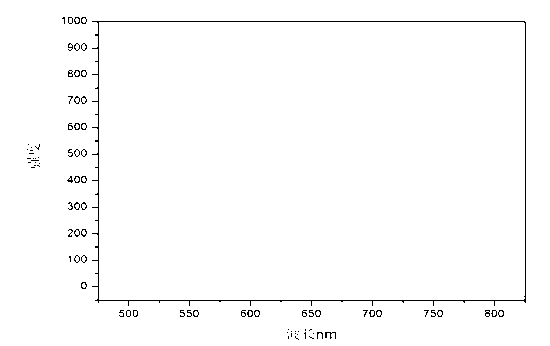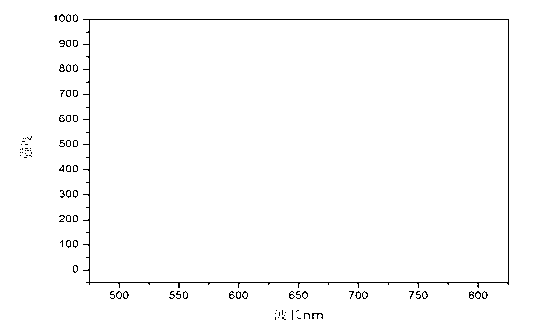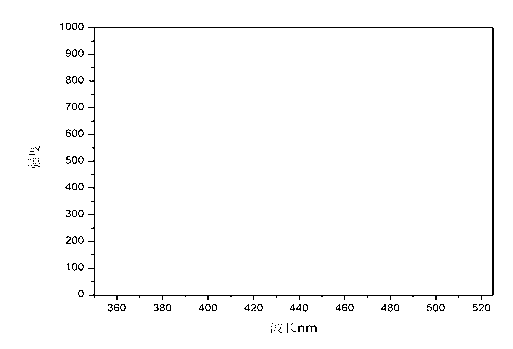Sm3+ glass doping brilliant glass ceramics and preparation method thereof
A technology of glass-ceramic and composite crystal, which is applied in the field of Sm3+ doped luminescent glass-ceramic and its preparation, can solve the problem of less research on luminescence properties, and achieve the effects of stable and reliable process conditions, simple process steps and pure luminosity
- Summary
- Abstract
- Description
- Claims
- Application Information
AI Technical Summary
Problems solved by technology
Method used
Image
Examples
Embodiment 1
[0026] Weigh 6.91g of zinc oxide, 11.71g of boric acid, 12.63g of silicon dioxide, 2.41g of aluminum oxide, 2.57g of sodium carbonate, 0.72g of titanium dioxide, and 0.26g of samarium oxide.
[0027] Grind the above raw materials with a mortar to obtain a uniform powder. Put the ground raw material into a corundum crucible, put it in a resistance furnace, and melt it at a temperature of 1500°C, then pour the molten raw material into glass, then put it into a muffle furnace, and nucleate it at 575°C 2h, crystallized at 740°C for 6h, and finally obtained 23ZnO-22B 2 o 3 -42SiO 2 Luminous glass-ceramic.
[0028] The glass-ceramic obtained in this example is orange-red under the excitation of 406nm blue-violet light. Such as figure 1 As shown, the glass-ceramic excitation wavelength range of this embodiment is 475-850nm, such as figure 2 As shown, the emission wavelength range of the glass-ceramics in this embodiment is 350-525nm. When excited with 406nm, the fluorescence e...
Embodiment 2
[0030] Weigh 6.91g of zinc oxide, 11.71g of boric acid, 12.63g of silicon dioxide, 2.41g of aluminum oxide, 2.57g of sodium carbonate, 0.72g of titanium dioxide, and 0.61g of samarium oxide.
[0031] Grind the above raw materials with a mortar to obtain a uniform powder. Put the ground raw material into a corundum crucible and put it in a resistance furnace, melt it at 1500°C, then cast the molten raw material into glass, then put it into a muffle furnace, and nucleate it at 575°C for 2 hours , crystallized at 740°C for 6h, and finally obtained 23ZnO-22B 2 o 3 -42SiO 2 Luminous glass-ceramic.
[0032] The glass-ceramic obtained in this example is orange-red under the excitation of 406nm blue-violet light. The excitation wavelength range of the glass-ceramic is 475-850nm. The emission wavelength ranges from 350 to 525nm. When excited by 406nm, the fluorescence emission of the vitreous body at 610nm reaches the best, that is, the main emission peak is at 610nm, the maximum ...
Embodiment 3
[0034] Weigh 6.91 g of zinc oxide, 11.71 g of boric acid, 12.63 g of silicon dioxide, 2.41 g of aluminum sesquioxide, 2.57 g of sodium carbonate, 0.72 g of titanium dioxide, and 0.78 g of samarium trioxide.
[0035] Grind the above raw materials with a mortar to obtain a uniform powder. Put the ground raw material into a corundum crucible and put it in a resistance furnace, melt it at 1500°C, then cast the molten raw material into glass, then put it into a muffle furnace, and nucleate it at 575°C for 2 hours , crystallized at 740°C for 6h, and finally obtained 23ZnO-22B 2 o 3 -42SiO 2 Luminous glass-ceramic.
[0036] The glass-ceramic obtained in this example is orange-red under the excitation of 406nm blue-violet light. Such as image 3 As shown, the glass-ceramic excitation wavelength range of this embodiment is 475-850nm, such as Figure 4 As shown, the emission wavelength range of the glass-ceramic in this embodiment is 350-525nm. When excited with 406nm, the fluoresce...
PUM
| Property | Measurement | Unit |
|---|---|---|
| wavelength | aaaaa | aaaaa |
Abstract
Description
Claims
Application Information
 Login to View More
Login to View More - R&D
- Intellectual Property
- Life Sciences
- Materials
- Tech Scout
- Unparalleled Data Quality
- Higher Quality Content
- 60% Fewer Hallucinations
Browse by: Latest US Patents, China's latest patents, Technical Efficacy Thesaurus, Application Domain, Technology Topic, Popular Technical Reports.
© 2025 PatSnap. All rights reserved.Legal|Privacy policy|Modern Slavery Act Transparency Statement|Sitemap|About US| Contact US: help@patsnap.com



